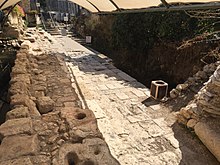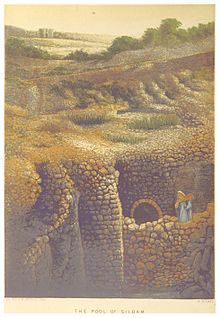Pool of Siloam

The Pool of Siloam (Arabic: بركه سلوان, Hebrew: בריכת השילוח, Breikhat HaShiloah) refers to a number of rock-cut pools on the southern slope of the City of David / Wadi Hilweh, considered by some archaeologists to be the original site of Jerusalem, located outside the walls of the Old City to the southeast. The pools were fed by the waters of the Gihon Spring, carried there by two aqueducts.
The Lower Pool or "Old Pool" was historically known as Birket el Hamra, literally "the red pool".
History[edit]
Hezekiah's Lower Pool[edit]
The (Lower) Pool of Siloam was built during the reign of Hezekiah (715–687/6 BCE), to leave besieging armies without access to the spring's waters. The pool was fed by the newly constructed Siloam tunnel. The old Canaanite tunnel had been very vulnerable to attackers, so, under threat from the Assyrian king Sennacherib, Hezekiah sealed up the old outlet of the Gihon Spring and the Upper Pool, and built the new underground Siloam tunnel in place of the older tunnel (2 Chronicles 32:2-4). During this period the Pool of Siloam was therefore sometimes known as the Lower Pool (Isaiah 22:9).[1]
The Canaanite pool-the biblical Upper Pool[edit]
The Canaanite city had a water system by which the Gihon Spring emptied into a large open basin at its source, before being conveyed along the eastern city walls by an aqueduct that opened at several spots towards the valley below, where the water irrigated agricultural fields. This basin is sometimes known as the Upper Pool (2 Kings 18:17, Isaiah 7:3).[1] It seems likely that during the Governorship of Nehemiah (from 445 BCE), when city had to be rebuilt after the destruction by Nebuchadnezzar from 586-87 and the return from Babylonian captivity, the pool was also known as the King's Pool (Nehemiah 2:14).
Association with Jesus[edit]
The pool was reconstructed no earlier than the reign of Alexander Jannaeus (103-76 BCE), although it is not clear whether this pool was in the same location as the earlier pool built by Hezekiah — if so, all traces of the earlier construction have been destroyed. The pool remained in use during the time of Jesus. According to the Gospel of John, Jesus sent "a man blind from birth" to the pool in order to complete his healing.[2] The pool has a symbolic meaning in the Gospel of John. Jesus is the one sent by the Father (cf. John 5:38; 8:42; 9:4; 13:20) who, in turn, sends the man blind from birth to the pool that means “Sent” (see narrative aside in John 9:7) to receive sight/insight.[3] As a freshwater reservoir, the pool would have been a major gathering place for ancient Jews making religious pilgrimages to the city. Some scholars, influenced by Jesus commanding the blind man to wash in the pool, suggest that it was probably used as a mikvah (ritual bath).[4] However, mikvahs are usually much smaller in size, and if the pool were a mikvah, it would be the largest ever found by a substantial margin.[5] Yoel Elitzur has proposed that the pool was used for swimming rather than ritual immersion.[6]
21st century[edit]
The pool was rediscovered during an excavation work for a sewer in the autumn of 2004, by Ir David Foundation workers, following a request and directions given by archaeologists Eli Shukron accompanied by Ori Orbach from the Israel Nature and Parks Authority. Archaeologists Eli Shukron and Ronny Reich (working with the Israel Antiquities Authority) uncovered stone steps, and it became obvious that these steps were likely to have been part of the Second Temple period pool. Excavations commenced and confirmed the initial supposition; the find was formally announced on August 9, 2005, and received substantial international media attention.[7][8] The excavations also revealed that the pool was 225 feet wide, and that steps existed on at least three sides of the pool. A portion of this pool remains unexcavated, as the land above it is owned by a nearby Greek Orthodox church and is occupied by an orchard known as the King's Garden (compare Nehemiah 3:15). The pool is not perfectly rectangular, but a soft trapezoid. There are three sets of five steps, two leading to a platform, before the bottom is reached, and it has been suggested that the steps were designed to accommodate various water levels. The pool is stone-lined, but underneath, there is evidence of an earlier version that was merely plastered (to help it retain water). Coins from the reign of Alexander Jannaeus were found embedded in the plaster lining of the pool, and therefore provide a secure earliest date for the pool's (re-)construction.
The pool was destroyed and covered after the First Jewish–Roman War in the year 70. Dating was indicated by a number of coins discovered on the stones of the patio near the pool to the north, all from the days of the Great Revolt. The latest coin is dated with "4 years to the day of the Great Revolt", meaning the year 69. In the years following the destruction, winter rains washed alluvium from the hills down to the valley and down the slopes of Mount Zion to the west of the pool; the pool was filled with silt layers (up to 4 m in some places) until it was covered completely.
Late Roman nymphaeum[edit]
Roman sources mention a Shrine of the Four Nymphs (Tetranymphon), a nymphaeum built by Hadrian during the construction of Aelia Capitolina in 135[9][10][11] and mentioned in Byzantine works such as the 7th-century Chronicon Paschale; other nymphaea built by Hadrian, such as that at Sagalassos, are very similar.[12] It is unlikely that this shrine was built on the site of the Second Temple Pool of Siloam, but it may have been a precursor to the Byzantine reconstruction, below.
Byzantine pool and church[edit]

In the 5th century, a pool was constructed at the end of the Siloam Tunnel, at the behest of Empress Aelia Eudocia. This pool survives to the present day, surrounded on all sides by a high stone wall with an arched entrance to Hezekiah's Tunnel. This pool is around 70 yards from the Second Temple Pool of Siloam, and is significantly smaller. Until the discovery of the Second Temple pool of Siloam, this pool was wrongly thought to be the pool described in the New Testament and Second Temple sources.
See also[edit]
References[edit]
- ^ a b The City of David; revisiting early excavations; English translations of reports by Raymond Weill and L-H. Vincent/ notes and comments by Ronny Reich; edited by Hershel Shanks. Pages 197-227.
- ^ John 9
- ^ James L. Resseguie, Narrative Criticism of the New Testament: An Introduction (Grand Rapids, MI: Baker Academic, 2005), 149.
- ^ John 9:6-11
- ^ James H. Charlesworth, quoted in Los Angeles Times, article: Biblical Pool Uncovered in Jerusalem, 9th August 2005
- ^ Yoel Elitzur (2008). "The Siloam Pool — 'Solomon's Pool' — was a swimming pool". Palestine Exploration Quarterly. 140 (1): 17–25. doi:10.1179/003103208x269114.
- ^ Archaeologists identify traces of 'miracle' pool. Siloam Pool was where Jesus was said to cure blind, AP, Dec. 23, 2004 [1]
- ^ Rossner, Rena (January 26, 2006). "The once and future city". The Jerusalem Post. Retrieved November 15, 2009.
They have also discovered thousands of fish bones that, together with the bullae were found in an area that Reich and Shukran believe to be the Shiloah Pool, used as a ritual bath for the Temple Mount, and a tiled road which ends at the pool and has its origins near the Temple Mount. Ostensibly, this is the road that worshippers used to go back and forth between the Shiloah Pool and the Temple Mount.
- ^ Dave Winter, Israel handbook, (1999) p 180
- ^ André Grabar, Martyrium, (1946), volume 1, page 193
- ^ E. Wiegand, The Theodosian Monastery, (1929), volume 11, page 50-72
- ^ for example, see this view
Further reading[edit]
- Rabbi Yitzchak Levy (2015) "The place" in the world. The Shiloach Pool . The Zomet Institute
- Elitzur, Yoel (2008). "The Siloam Pool — 'Solomon's Pool' — was a Swimming Pool". Palestine Exploration Quarterly. 140 (1): 17–25. doi:10.1179/003103208x269114.
- Reich, R.; Shukron, E.; Lernau, O. (2007). "Recent Discoveries in the City of David, Jerusalem". Israel Exploration Journal. 57: 153–168.
- Image and text of the Siloam inscription
- Shanks, Hershel (September–October 2005). "The Siloam Pool Where Jesus Cured the Blind Man". Biblical Archaeology Review. 31 (5): 16–23.. Click here for an abridged article in html or the full article in pdf format.
- Pictures of the recently rediscovered Pool of Siloam from holylandphotos.org
- Herbermann, Charles, ed. (1913). . Catholic Encyclopedia. New York: Robert Appleton Company.
- Fuad Abu-Taa', Aliza Van Zaiden and Tsagai Asamain, Conservation of the Shiloah Pool and preparing it for the public , Israel Antiquities Authority Site - Conservation Department
Coordinates: 31°46′14″N 35°14′06″E / 31.77056°N 35.23500°E





